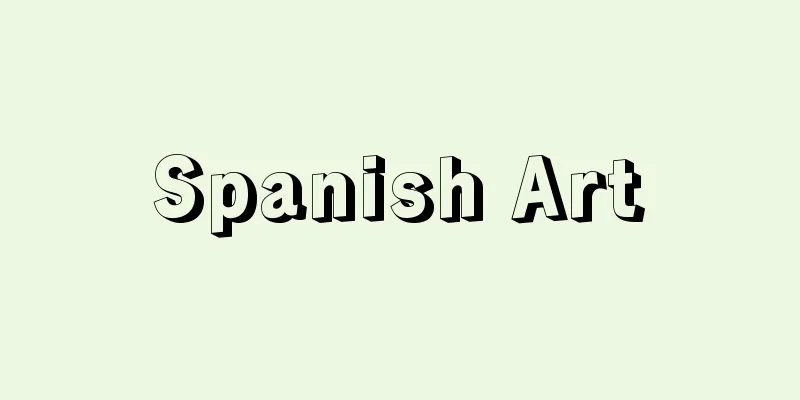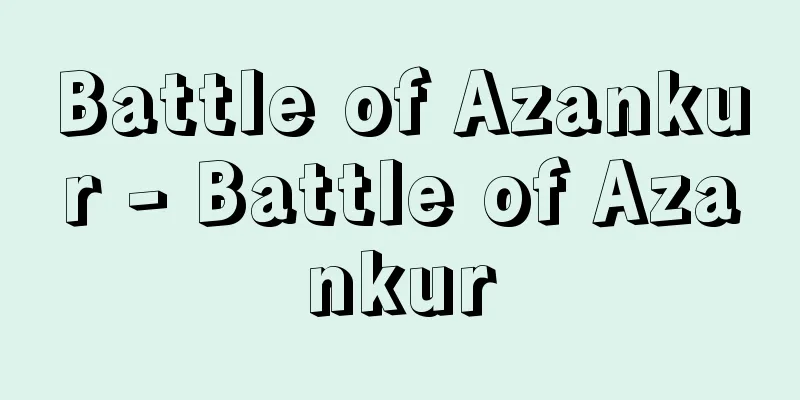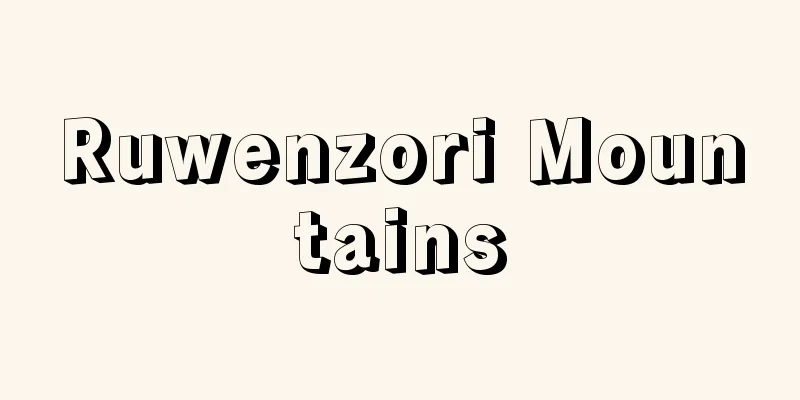Spanish Art

|
Spain is located at the crossroads of four cultural spheres: Europe, Africa, the Mediterranean, and the Atlantic. For this reason, it has been a melting pot of ethnicities and cultures since ancient times, and its history has shown intermittent development due to external shocks. Under these unique conditions, art also produced a unique hybrid style, and from the Middle Ages to the 18th century, it developed in close connection with politics and Catholicism as the state religion. Spanish art experienced a period of great development in the 17th and 20th centuries, with painting being the central genre, and generally speaking, it showed strong tendencies toward naturalism, expressionism, and anthropocentrism. [Kanyoshi Keizo] Ancient times - a melting pot of peoples and culturesThere are many prehistoric artistic heritages, including the Paleolithic cave paintings of Altamira, but it was not until the Phoenicians, Greeks and Carthaginians, who migrated to the Iberian Peninsula for colonial purposes, introduced Eastern art to the region that unique plastic arts emerged. Under their influence, the indigenous Iberians developed Iberian art, centered on highly plastic sculpture and pottery, from the 4th century BC. Ruins from the 7th century Roman colony are also scattered around Italy, including in Italica and Mérida, and excavations are still ongoing. The Visigothic period (5th to early 8th centuries), brought by Germanic Christians who invaded from the north, left behind art that combined the Roman heritage with northern abstraction. [Kanyoshi Keizo] The Middle Ages: The Coexistence and Conflict of Two ReligionsIn 711, Muslims invaded Spain from North Africa, and the period of coexistence and conflict between Christianity and Islam continued until 1492, greatly influencing the development of Spanish art thereafter. Muslims, mainly in the south, developed a succession of magnificent architectural styles, from the Mezquita (Great Mosque, 8th-10th century) in Cordoba to La Giralda Tower (12th century) in Seville and the Alhambra Palace in Granada (14th-15th century), and their tendency towards excessive decoration and unique sense of space also influenced Christian architecture. Meanwhile, in the Christian north, Asturian art (8th-10th century) continued the Visigothic tradition, and Mozarabic art (9th-10th century) used techniques learned from Islam to create Christian themes. The latter was especially famous for its miniatures, and its representative work, the "Commentary on the Apocalypse of Beatus" (the Beato edition), spawned numerous copies and influenced subsequent Spanish painting. Reflecting the strengthening of ties with Western Europe, the two major styles of the Middle Ages, Romanesque (11th to 13th centuries) and Gothic (13th to 16th centuries), flourished. Romanesque architecture developed in two ways: Lombard in Catalonia, centered around the Monastery of Ripoll, and French along the Camino de Santiago pilgrimage route ending at the Cathedral of Santiago de Compostela, and became more ethnic in character as it traveled south. Sculpture was also revived, and in addition to those attached to architecture such as the "Arco de Gloria," many highly colored wooden religious sculptures were created, which continued until the 18th century. Mural painting was also popular, and the Art Museum of Catalonia in Barcelona has the world's largest collection. As the Reconquista (war of recovery) against Islam progressed, Gothic became a triumphant style, and spread to the southernmost tip of the peninsula. The 13th century cathedrals of Leon, Burgos, and Toledo imitated French architecture, but as one went south, it became more Spanish, emphasizing horizontality, as in Seville Cathedral. Meanwhile, the Mudejar style, a fusion of Islamic, Romanesque, and Gothic styles, was born. Sculpture became more naturalistic and expressive. Painting was influenced by the Italian Trecento (the style of the 1300s) and International Gothic, and actively absorbed the 15th century Netherlandish style, laying the foundations for Spanish Realism. [Kanyoshi Keizo] 16th and 17th centuries--Golden AgeSpain, which had expelled Islam and unified its territory at the end of the 15th century, quickly became the world's greatest power with the "discovery of the New World" and the accession of Holy Roman Emperor Charles V of the Habsburg family to the throne of Spain (Carlos I), and then became the standard-bearer of Catholicism in opposition to the religious revolution brought about by the emerging Protestantism. The 16th century was the era of Renaissance and Mannerism, and the 17th century was the era of Baroque, but in Spain it was the spirit of the Counter-Reformation that inspired the art of both of these centuries. Renaissance architecture began with the Isabelline style, which had strong Gothic colors, and then with the Plateresque style, which is uniquely Spanish and excessively decorative, as seen in the facade of the University of Salamanca, and ended up with a purely Italian style, as seen in the monastery and palace of Juan de Herrera (c. 1530-1597). Sculpture and painting, on the other hand, started with Mannerism and established their Spanish individuality in the following century. In sculpture, painted wooden expressionist icons for altar screens by Alonso Berruguete (1489-1561) and others dominated. In painting, the Golden Age was ushered in by the religious painter El Greco, following "Holy" Morales (Luis de Morales) and Alonso Sánchez Coello (1531/1532-1588), the first Spanish portrait painter. Baroque architecture was also characterized by excessive decoration, as in Plateresco, and the Churriguera family and their disciples were active in the Baroque. Traditional iconography was also the mainstream in sculpture, and the expressionist Gregorio Fernández (Hernández, c. 1576-1636) from Castile and the somewhat sweet Juan Martínez Montañés (1568-1649) from Andalusia were prominent. In painting, great masters such as José de Ribera, Francisco de Zurbarán, Diego Velázquez, Bartolomé Murillo, and Juan de Valdés Leal emerged, who, while making use of the lessons of the Venetian and Flemish schools, developed Spanish-style realism, creating a golden age. [Kanyoshi Keizo] The 18th and 19th Centuries: From the Rule of the Bourbons to the Beginnings of Modern ArtThe French Bourbon royal family, who became rulers of Spain as a result of the War of Succession that began in 1700, introduced the Academy system and forced neoclassicism on the country, while also inviting many foreign artists to Spain, as they disliked the Baroque tendencies of the Spanish people. Spanish art faced a major crisis in the 18th century, but it was Francisco de Goya, the pioneer of modern painting, who caused a great explosion of paradoxes at that time. After Goya, Spanish art once again stagnated, but it entered a second golden age from the end of the 19th century to the 20th century. [Kanyoshi Keizo] 20th centuryUntil the Spanish Civil WarWith the exception of the architect Antonio Gaudi, many of Spain's leading artists in the first half of the 20th century were active in Paris, including Pablo Picasso and Joan Gris, who pioneered Cubism, Salvador Dali and Joan Miro, the Surrealists Julio Gonzalez (1876-1943), who is known for providing technical advice to Picasso on his iron sculptures, and the late Cubist sculptor Pablo Gargallo (1881-1934). However, it is said that their works are rooted in the climate and spirit of Spain or Catalonia. On the other hand, apart from these mainstream trends, Ignacio Zuloaga (1870-1945) and José Solana, among others, were painting dark and tragic folk themes in sympathy with the "Generation of '98," which emerged in response to the emergence of the regionalist movement and the defeat in the Spanish-American War (1898). [Kenjiro Hosaka] From the Spanish Civil War to the 1950sAt the 1937 Paris World's Fair, held in the midst of the Spanish Civil War (1936-1939), the Spanish pavilion was a propaganda work criticizing the Franco regime, while the other pavilions were filled with optimistic expressions of science and technology. Designed by Barcelona architect and urban planner Josep Lluis (José Luis) Sert (1902-1983), the interior of this pavilion was filled with the anger of artists against the injustice and massacres that had taken place during the civil war. One of these was Picasso's Guernica. Under the Franco regime, art was in a state of stagnation due to censorship and the control of the Academy. However, in 1947, Dau al Set, a group of artists, writers and philosophers including Antoni Tàpies, was founded in Barcelona. Influenced by Surrealism and Dada, it sought to express the subconscious, and once again breathed a sense of dynamism into Catalonia. Following this, El Paso was founded in Madrid in 1957, and became the base of the Spanish Art Informel movement with Antonio Saura (1930-1998) and Manolo Millares (1926-1972). [Kenjiro Hosaka] 1960s and afterSince the 1960s, there have been Eduardo Chillida (1924-2002), known for his minimalist but massive sculptures, Antonio Lòpez García (1936- ), who is known for his fantastical realism, and Eduardo Arroyo (1937-2018), who is known for his pop and satirical works. In subsequent generations, Susana Solano (1946- ), Juan Muñoz (1953-2001), and Cristina Iglesias (1956- ), have been notable for their three-dimensional expression. In the 1990s, the Basque government planned a regeneration project for Bilbao, and the commercial success of the Guggenheim Museum Bilbao and the opening of the Barcelona Museum of Contemporary Art attracted much attention, but they also signified the globalization of art. [Kenjiro Hosaka] ArchitectureIn the early 20th century, the Spanish version of Art Nouveau, known as Modernismo, flourished in Barcelona. Gaudi's architecture, with its unique structure and decoration that went beyond any other style, shocked many avant-garde artists. However, the oppression of the Franco regime that followed led to the exile of Sert and Félix Candela (1910-1997), which led to the stagnation of Spanish architecture. After a period of modernism revival in the 1960s, the 1970s saw the emergence of Ricardo Bofill (1939- ), a historical classicist, and Rafael Moneo (1937- ), a critical regionalist and contextualist. In the 1980s, the architecture of Santiago Calatrava (1951- ), with its original space and structure, attracted attention. [Kenjiro Hosaka] "World Art Encyclopedia 17: Spanish Art" (1962, Kodansha) edited by Eikichi Hayashiya and Keizo Kanyoshi " ▽ "World Museums 16: Spanish and Portuguese Museums" (1979, Kodansha) edited by Keizo Kanyoshi" ▽ "Ecran World Art 16: Spain and Portugal" (1981) edited and published by Shufu no Tomosha" ▽ "Primary Color World Art 5: Spain and Portugal" (1983, Shogakukan)" ▽ "World Art Journey 12: Spain Stories" (1989, Sekai Bunka Publishing)" ▽ "European Architecture and Interior Guide - From Historical Buildings to Museums and Shops, Vol. 1" by Kyoko Tajima, Masako Ueda, and Kazuhiko Hoshi (1991, Newhouse Publishing)" ▽ "Characteristics of Spanish Architecture" by F. Chueca, translated by Toritoshi Torii (1991, Kajima Publishing Co., Ltd.)" ▽ "Cathedrals of Spain" by Nichito Sugai (1992, Graphic-sha Publishing) ▽ "Light and Shadow of Spain - A Journey through Romanesque Art" by Masugi Muneo (1992, Nihon Keizai Shimbun) ▽ "Spanish Art Appreciation Travelogue 1: Madrid and Toledo" by Okamura Takao (1995, Bijutsu Shuppansha) ▽ "Spanish Art Appreciation Travelogue 2: Barcelona and Valencia" by Okamura Takao (1996, Bijutsu Shuppansha) ▽ "Spain of the Great Masters" by Kanyoshi Keizo (1997, Mainichi Shimbun) [References] | | | | | | | | | | | | | | | | | | | | | | |A Gothic cathedral completed in 1493 after 270 years of construction spanning the 13th to 15th centuries. You can see all stages of the Spanish Gothic style, and there are also many sculptures and paintings. Part of the World Heritage Site "Historic City of Toledo" (Spain, registered in 1986) Spain Toledo ©Shogakukan "> Toledo Cathedral A tall tower rising above the "Gate of the Nativity (Nativity Facade)" on the east side. Various sculptures are applied all over the facade. Part of the World Heritage "Works of Antonio Gaudi" (Spain, registered in 1984 and 2005) Barcelona, Spain ©Kyoko Kamita "> Sagrada Familia 1577-1579 Oil on canvas (Collection of the Art Institute of Chicago ) El Greco "Assumption of the Virgin" 1787-1788 Oil on canvas, Metropolitan Museum of Art Goya's "Manuel Osorio Manrique" Source: Shogakukan Encyclopedia Nipponica About Encyclopedia Nipponica Information | Legend |
|
スペインはヨーロッパ、アフリカ、地中海、大西洋という四つの文化圏の接点に位置する。そのために古代から民族と文化のるつぼと化し、歴史も外部からの衝撃によって断続的な展開を示してきた。こうした特殊条件のもとで美術も、特異な混合様式を生むとともに、中世から18世紀にかけて、政治と国教としてのカトリックに密接に結び付いて発展した。スペイン美術は17世紀と20世紀に一大発展期を迎えたが、その中心ジャンルは絵画で、総体的にいって自然主義、表現主義、人間中心主義的な傾向が強い。 [神吉敬三] 古代――民族と文化のるつぼ旧石器時代のアルタミラ洞窟(どうくつ)壁画をはじめ、原始時代の美術遺産も数多いが、イベリア半島に個性的な造形美術が現れたのは、植民のために移住したフェニキア人、ギリシア人、カルタゴ人が東方美術を伝えてからで、その影響下に、先住イベロ人は紀元前4世紀から、造形性豊かな彫刻と陶器を中心とするイベリア美術を展開した。 7世紀に及ぶローマ属領時代の遺跡も、イタリカ、メリダをはじめ各地に散在し、発掘が続いている。北方から侵入したゲルマン系のキリスト教徒による西ゴート時代(5~8世紀初頭)は、ローマの遺産に北方の抽象傾向を加えた美術を遺(のこ)した。 [神吉敬三] 中世――二つの宗教の併存対立711年イスラム教徒が北アフリカから侵入、1492年までキリスト教とイスラム教の併存対立時代が続き、その後のスペイン美術の展開に大きな影響を与えた。イスラム教徒は南部を中心に、コルドバのメスキータMezquita(大モスク、8~10世紀)からセビーリャのヒラルダの塔La Giralda(12世紀)、そしてグラナダのアルハンブラ宮殿(14~15世紀)に至る華麗な建築様式を次々と展開、その装飾過多の傾向と特異な空間感情は、キリスト教建築にも影響を与えた。 一方、北部のキリスト教圏では、西ゴートの伝統を継承するアストゥリアス美術(8~10世紀)、イスラムに学んだ技術でキリスト教の主題を扱ったモサラベ美術(9~10世紀)などが行われた。後者ではとくにミニアチュールが有名で、代表作『ベアトゥスの黙示録注解書』(ベアト本)は数多くの写本を生み、その後のスペイン絵画に影響を与えた。 続いて西ヨーロッパとの関係強化を反映し、中世の二大様式であるロマネスク(11~13世紀)とゴシック(13~16世紀)が栄えた。ロマネスク建築は、リポール修道院などを中心とするカタルーニャ地方のロンバルディア系と、サンティアゴ・デ・コンポステラ大聖堂を終着点とするサンティアゴ巡礼路に沿ったフランス系という二様の展開をみせ、南下するにしたがって民族的な性格を増していった。彫刻も復活し、「栄光の門」など建築に付随したもののほかに、18世紀まで行われることとなる木造極彩色の聖像彫刻が多くつくられた。壁画も盛んに行われ、バルセロナのカタルーニャ美術館には世界一のコレクションがある。 ゴシックは、イスラムに対する国土回復戦争(レコンキスタ)の進展とともに勝利者様式となり、半島の最南端にまで及んだ。建築は、13世紀のレオン、ブルゴス、トレドの各大聖堂はフランスに倣ったが、南下するにしたがってスペイン化され、セビーリャ大聖堂のように水平性が強調されていった。その間、イスラム様式とロマネスク、ゴシックがそれぞれに融合したムデハル様式も生まれた。彫刻は、自然主義的傾向と表現性を増した。絵画は、イタリア・トレチェント(1300年代の様式)と国際ゴシックの影響に続き、15世紀フランドル派を積極的に吸収して、スペイン・レアリスム絵画の基礎を築いた。 [神吉敬三] 16、17世紀――黄金時代15世紀末にイスラムを駆逐して国土統一を果たしたスペインは、「新大陸の発見」、ハプスブルク家の神聖ローマ皇帝カール5世のスペイン王即位(カルロス1世)などにより、一気に世界一の大国となり、今度は新興プロテスタントによる宗教革命に対抗するカトリックの旗手となった。16世紀はルネサンスとマニエリスム、17世紀はバロックの時代だが、スペインでは、これら両世紀の美術を鼓舞したのは、対抗宗教改革の精神であった。 ルネサンス建築は、ゴシック的な色彩の強いイサベル様式に続いて、サラマンカ大学正面などにみるスペイン独特の装飾過剰なプラテレスコ様式に始まり、ホアン・デ・エレーラJuan de Herrera(1530ごろ―1597)のエル・エスコリアル(修道院・離宮)にみられる純イタリア様式に行き着いた。彫刻と絵画は逆に、マニエリスムを出発点として、次の世紀にスペイン的個性を確立する。彫刻ではアロンソ・ベルゲーテAlonso Berruguete(1489―1561)らによる祭壇衝立(ついたて)用の木造彩色の表現主義的な聖像が主流を占めた。絵画では、「聖なる」モラレス(ルイス・デ・モラレス)、スペイン初の肖像画家アロンソ・サンチェス・コエーリョAlonso Sánchez Coello(1531/1532―1588)に続き、宗教画家エル・グレコが黄金時代の到来を告げた。 バロック建築もプラテレスコ同様に過剰装飾を特徴とし、チュリゲーラChurriguera一族とその弟子たちが活躍した。彫刻も、伝統的な聖像彫刻が主流をなし、カスティーリャの表現主義的なグレゴリオ・フェルナンデスGregorio Fernández(Hernández、1576ごろ―1636)、アンダルシアのやや甘美な傾向のホアン・マルティネス・モンタニェースJuan Martínez Montañés(1568―1649)らが傑出している。絵画では、ホセ・デ・リベラ、フランシスコ・デ・スルバラン、ディエゴ・ベラスケス、バルトロメ・ムリーリョ、ホアン・デ・バルデス・レアールらの巨匠が輩出、ベネチア派とフランドル派の教訓を生かしながら、スペイン的なレアリスム絵画を展開し黄金時代を築いた。 [神吉敬三] 18~19世紀――ブルボン王家の支配から近代美術の草創1700年に始まった王位継承戦争の結果スペインの支配者となったフランス系ブルボン王家は、アカデミー制度を導入し、新古典主義を強制するとともに、スペイン人のバロック的性向を嫌って、外国人芸術家を数多く招聘(しょうへい)した。18世紀にスペイン美術は大きな危機に直面したが、そのとき背理の大爆発を遂げたのが近代絵画の先駆者フランシスコ・デ・ゴヤであった。ゴヤ以後ふたたび沈滞したスペイン美術は、19世紀末から20世紀にかけて第二の黄金時代を迎えることになる。 [神吉敬三] 20世紀スペイン内戦まで建築家であったアントニオ・ガウディを例外として、キュビスムを先導したパブロ・ピカソ、ホアン・グリス、シュルレアリスムのサルバドール・ダリやジョアン・ミロ、ピカソの鉄彫刻に技術上の助言を与えたことでも知られるフリオ・ゴンザレスJulio Gonzalez(1876―1943)、後期キュビスム彫刻のパブロ・ガルガーリョPablo Gargallo(1881―1934)など、20世紀前半のスペインを代表する芸術家の多くはパリで活躍した。しかし彼らの作品には、スペイン、あるいはカタルーニャの風土や精神が根底にあると指摘される。また一方で、そうした主流の動向とは別に、地域主義運動の噴出やアメリカ・スペイン戦争(1898)の敗北が引き金となり登場した「98年の世代」に共鳴して、イグナシオ・スロアーガIgnacio Zuloaga(1870―1945)やホセ・ソラーナらが、暗く悲惨な民衆的テーマを描いていた。 [保坂健二朗] スペイン内戦から1950年代スペイン内戦(1936~1939)の真っただ中の1937年に行われたパリ万国博覧会において、他館が科学技術を称揚する楽観的雰囲気のなか、スペイン・パビリオンだけはフランコ政権を批判するプロパガンダの様相を呈していた。バルセロナの建築家、都市計画家のホセ・ルイス・セルトJosep Lluis(José Luis) Sert(1902―1983)によって設計されたこのパビリオンの室内は、内戦中の不正、虐殺に対する芸術家の怒りで埋めつくされた。ピカソによる『ゲルニカ』はその一つである。 フランコ政権下の芸術は、検閲とアカデミーの支配による停滞状態にあった。しかし1947年、アントニ・タピエスを含む芸術家、文学者、哲学者がバルセロナで創設した「ダウ・アル・セットDau al Set」は、シュルレアリスムやダダの影響下、潜在意識を表現しようとするもので、カタルーニャの地にふたたび同時代美術の躍動感を吹き込んだ。それに続いて1957年マドリードで創設された「エル・パソEl Paso」は、アントニオ・サウラAntonio Saura(1930―1998)やマノロ・ミリャーレスManolo Millares(1926―1972)により、スペインにおけるアンフォルメル運動の拠点となった。 [保坂健二朗] 1960年代以降1960年代以降には、ミニマルだが量塊感のある彫刻で知られるエドゥアルド・チリダEduardo Chillida(1924―2002)、空想的リアリズムのアントニオ・ロペス・ガルシアAntonio Lòpez García(1936― )、ポップで風刺的なエドゥアルド・アッローヨEduardo Arroyo(1937―2018)がいる。それ以降の世代では、スザーナ・ソラーノSusana Solano(1946― )、フアン・ムニョスJuan Muñoz(1953―2001)やクリスティーナ・イグレシアスCristina Iglesias(1956― )による立体表現の活躍が目覚ましい。1990年代、バスク行政府により計画されたビルバオ市再生プロジェクトの一つ、ビルバオ・グッゲンハイム美術館の商業的成功や、バルセロナ現代美術館の開館が話題となったが、一方でそれは、美術のグローバル化を意味してもいる。 [保坂健二朗] 建築建築では20世紀初頭、モデルニスモmodernismoとよばれるスペイン版アール・ヌーボーがバルセロナを中心に栄えた。なかでもガウディの建築は、もはやいかなる様式も超える独自の構造と装飾をもっており、多くの前衛的芸術家に衝撃を与えた。しかし続くフランコ政権期の圧政は、セルトやフェリックス・キャンデラFélix Candela(1910―1997)の亡命、すなわちスペイン建築の停滞を招いたのであった。1960年代のモダニズム復興期を経て、1970年代には歴史的古典主義のリカルド・ボフィルRicardo Bofill(1939― )や、批判的地域主義、文脈主義のラファエル・モネオRafael Moneo(1937― )による活躍が始まる。1980年代にはサンチアゴ・カラトラーバSantiago Calatrava(1951― )による独創的な空間と構造をもつ建築が注目を集めた。 [保坂健二朗] 『林屋永吉・神吉敬三編『世界美術大系17 スペイン美術』(1962・講談社)』▽『神吉敬三編『世界の博物館16 スペイン・ポルトガル博物館』(1979・講談社)』▽『主婦の友社編・刊『エクラン世界の美術16 スペイン・ポルトガル』(1981)』▽『『原色世界の美術5 スペイン・ポルトガル』(1983・小学館)』▽『『世界美術の旅12 スペイン物語』(1989・世界文化社)』▽『田島恭子・上田雅子・星和彦著『ヨーロッパの建築・インテリアガイド――歴史的建築物から美術館、ショップまで 上』(1991・ニューハウス出版)』▽『F・チュエッカ著、鳥居徳敏訳『スペイン建築の特質』(1991・鹿島出版会)』▽『菅井日人著『スペインの大聖堂』(1992・グラフィック社)』▽『馬杉宗夫著『スペインの光と影――ロマネスク美術紀行』(1992・日本経済新聞社)』▽『岡村多佳夫著『スペイン美術鑑賞紀行1 マドリード・トレド編』(1995・美術出版社)』▽『岡村多佳夫著『スペイン美術鑑賞紀行2 バルセロナ・バレンシア編』(1996・美術出版社)』▽『神吉敬三著『巨匠たちのスペイン』(1997・毎日新聞社)』 [参照項目] | | | | | | | | | | | | | | | | | | | | | | | |13~15世紀、270年の歳月を費やして1493年に完成したゴシック様式の聖堂。スペイン・ゴシック様式の全段階を見ることができ、彫刻や絵画も豊富である。世界文化遺産「古都トレド」の一部(スペイン・1986年登録) スペイン トレド©Shogakukan"> トレド大聖堂 東側の「降誕の門(生誕のファサード)」の上にそびえる高塔。ファサードの至る所にさまざまな彫刻が施されている。世界文化遺産「アントニオ・ガウディの作品群」の一部(スペイン・1984、2005年登録) スペイン バルセロナ©Kyoko Kamita"> サグラダ・ファミリア教会 1577~1579年 油彩シカゴ美術研究所所蔵"> エル・グレコ『聖母被昇天』 1787~1788年 油彩メトロポリタン美術館所蔵"> ゴヤ『マヌエル・オソーリオ・マンリーケ… 出典 小学館 日本大百科全書(ニッポニカ)日本大百科全書(ニッポニカ)について 情報 | 凡例 |
<<: Spanish dance - Spanish dance
Recommend
Kaiser, Georg
Born: November 25, 1878 in Magdeburg [Died] June 4...
Indian numerals - indosuuji
…It was introduced to Arabia and then from Arabia...
Checkered pattern - Ichimatsumoyo
A checkerboard pattern of alternating black and wh...
Gargoyle
Originally, it was a water spout in the shape of a...
Yoshida Bungoro
Bunraku puppeteer. His real name was Kawamura Min...
"Les rites de passage" (English spelling)
…He received his higher education in France and s...
Wife - Wife
〘Noun〙 ("sama" is a suffix) A respectful...
Uradome Castle
...This coast is home to Ajiro and Tago, the main...
Mine sweeping
A mine disposal method in which a small vessel (mi...
Ibara [city] - Ibara
A city in the southwest of Okayama Prefecture. It ...
Turtle and pheasant (English spelling) Qiu-zi; Ch`iu-tzǔ
The name of an ancient kingdom in Central Asia. It...
Modern - Imayo
(1) A popular song from the mid-Heian to the Kamak...
Post office savings - Ekiteikyokuchokin
…The postal savings system was established with t...
Block movement
…The earth's crust is thought to be made up o...
California Iris
…(b) Siberian iris consists of Iris sibirica L., ...







![Yatsushiro [city] - Yatsushiro](/upload/images/67cd0be2c27d2.webp)

